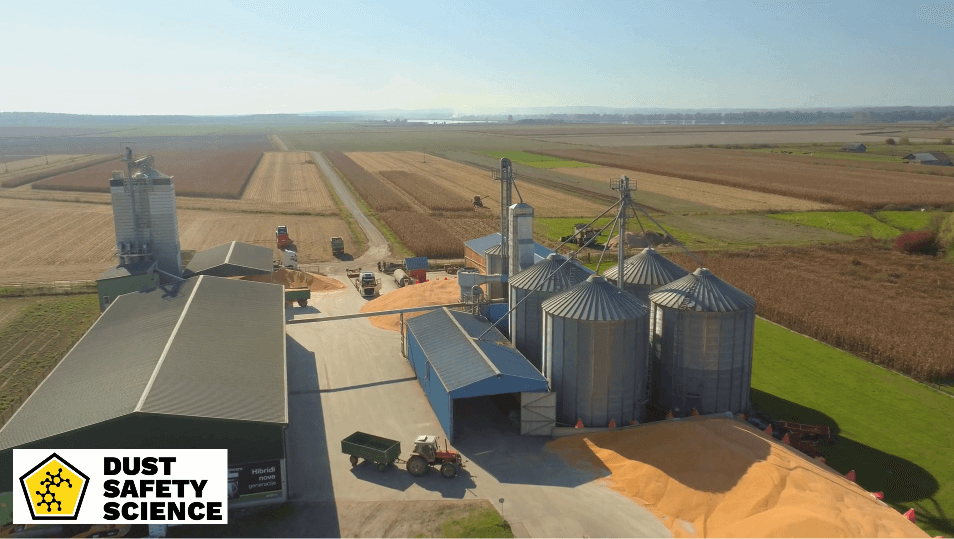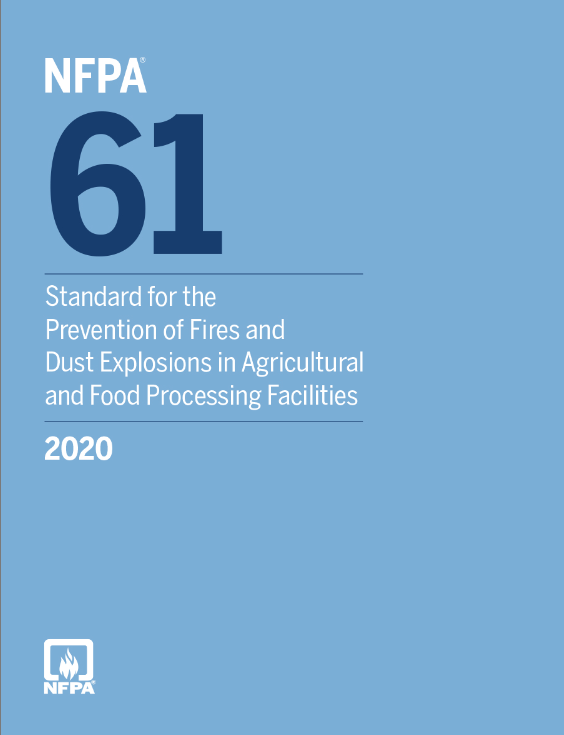Published May 29, 2024 Authored by Dr. Chris Cloney and Jon Barrett of Dust Safety Science

What is a Grain Silo Explosion?
A grain silo explosion, also known as a grain dust explosion, occurs when fine particles of grain dust become suspended in the air within a confined space and ignite. The primary explosion is caused by the confinement of airborne dust in contact with a heat source that ignites the dust. The explosive potential of grain dust is comparable to that of coal dust or sawdust, and when the conditions are right, a single spark can trigger a powerful explosion. To understand why grain dust is so explosive, we need to consider three critical factors of the fire triangle: the concentration of dust, the presence of an ignition source, and the availability of oxygen. When these elements come together in the right proportions, they create a highly volatile environment and a grain silo explosion.
In addition to the familiar fire triangle of oxygen, heat, and fuel (the dust), dispersion of combustible dust particles in sufficient quantity and concentration can cause rapid combustion known as a deflagration. If the event is confined by an enclosure such as a building, room, vessel, or process equipment, the resulting pressure rise may cause an explosion. These five factors (oxygen, heat, fuel, dispersion, and confinement) are known as the Dust Explosion Pentagon. If one element of the dust explosion pentagon is missing, an explosion cannot occur.
Grain dust particles are tiny and have a large surface area relative to their volume, making them highly flammable. In a confined space like a grain silo, these particles can accumulate and become suspended in the air, creating a dust cloud. If an ignition source, such as static electricity, hot machinery, or a spark from metal contact, is introduced, it can ignite the dust cloud, leading to a rapid combustion process known as deflagration.
Combustible dust refers to fine particles suspended in the air, capable of igniting under certain conditions, leading to fires or explosions. When these particles accumulate in sufficient quantities and encounter an ignition source, the resulting conflagration can be devastating. These airborne particles can ignite with a spark or flame, leading to combustion and potentially causing a fire or explosion. Other materials and products, such as grain dust, flour, paper, wood, metal, coal, plastic, cotton, and rubber that may combust in powdered form are extensive and include a wide range of materials. Some materials, such as Zinc or Potatoes are not combustible in larger pieces but can be when pulverized to fine dust. The US Occupational Safety and Health Administration (OSHA) maintains a comprehensive list of combustible materials.
What Causes Grain Silo Explosions?
One of the primary causes of grain silo explosions is the accumulation of grain dust. As grain is processed, transported, and stored, it generates dust and dust clouds. Over time, this dust can settle on surfaces and become suspended in the air, creating a highly combustible environment.
Various ignition sources can trigger a grain dust explosion. Common sources include:
- Static Electricity: Static electricity can build up during grain handling operations and discharge as sparks.
- Mechanical Sparks: Metal parts rubbing against each other or striking other materials can create sparks.
- Hot Surfaces: Overheated machinery, bearings, or other equipment can become ignition sources.
- Electrical Equipment: Faulty wiring or electrical equipment can produce sparks or heat that ignites dust.
Inadequate cleaning and maintenance practices can lead to the accumulation of grain dust in silos and processing facilities. Poor housekeeping increases the risk of dust explosions by allowing dust to build up over time.
Mechanical failures and equipment malfunctions can also contribute to the risk of explosions. For example, worn-out bearings, overheating motors, or conveyor belt issues can create sparks or heat that ignite dust and dust clouds.
The NFPA 654 Standard for the Prevention of Fire and Dust Explosions from the Manufacturing, Processing, and Handling of Combustible Particulate Solids, provides guidance on combustible dust suppression and dust control. The NFPA 654 Standard is referenced by OSHA’s Combustible Dust National Emphasis Program (NEP) to identify dust hazards and define mitigation strategies that help protect life and property. The standard provides industry-recognized safety practices for facility and systems design, process equipment protection, fugitive dust control and housekeeping, ignition source identification and control, fire protection, training and procedures, inspection, and maintenance.
The Occupational Safety and Health Administration (OSHA) in the United States defines combustible dust as “a solid material composed of distinct particles or pieces, regardless of size, shape, or chemical composition, which presents a fire or deflagration hazard when suspended in air or some other oxidizing medium over a range of concentrations. Understanding these characteristics is vital for identifying combustible dust hazards, managing the risks associated with combustible dust, ensuring workplace occupational safety and compliance, and preventing a combustible dust explosion.

Preventing Grain Silo Explosions
Preventing grain silo explosions requires a comprehensive approach that addresses the root causes and implements effective safety measures. Here are some key strategies for preventing these incidents. One of the most effective ways to prevent grain silo explosions is through regular cleaning and maintenance. Implementing dust control measures, such as using dust suppression systems and regularly cleaning surfaces, can reduce the accumulation of combustible dust. Regularly inspecting and maintaining equipment to ensure it is in good working condition can prevent malfunctions that could lead to ignition.
Installing monitoring and detection systems can help identify potential hazards before they lead to explosions. Dust sensors can detect high levels of airborne dust and trigger alarms or automatic shutdowns. Heat detectors can identify overheating equipment or hot spots that could ignite dust. Spark Detection and Suppression Systems can detect sparks and extinguish them before they can ignite a dust cloud.
Educating workers about the risks of grain dust explosions and training them in safe practices is essential. Teaching workers to recognize potential hazards and understand the conditions that can lead to explosions. Providing guidelines for safely handling and processing grain to minimize dust generation and accumulation.
Understanding Relevant Standards and Regulations
The Occupational Safety and Health Administration, OSHA, sets forth regulations related to grain handling facilities in the United States. These regulations, outlined in OSHA’s Grain Handling Facilities Standard (29 CFR 1910.272), cover requirements for:
- Housekeeping: Mandating regular cleaning to control dust accumulation.
- Grain Dryer Safety: Establishing guidelines for the safe operation of grain dryers.
- Preventative Maintenance: Requiring regular inspection and maintenance of equipment.
- Emergency Planning: Ensuring facilities have emergency action plans in place.
The National Fire Protection Association, NFPA, provides guidelines for the prevention of dust explosions in agricultural and industrial settings. NFPA 61: Standard for the Prevention of Fires and Dust Explosions in Agricultural and Food Processing Facilities, includes recommendations for:
- Dust Control: Implementing measures to minimize dust generation and accumulation.
- Ignition Source Control: Identifying and mitigating potential ignition sources.
- Explosion Protection: Installing explosion protection systems to mitigate the impact of explosions.
Conclusion
Grain silo explosions are a serious hazard with potentially devastating consequences. Understanding the causes, recognizing the risks, and implementing comprehensive prevention strategies are essential for safeguarding lives, property, and the environment. By prioritizing regular cleaning and maintenance, investing in modern equipment and technologies, and adhering to regulatory standards, the agricultural and industrial sectors can significantly reduce the risk of grain silo dust explosions and create a safer working environment for everyone involved.
